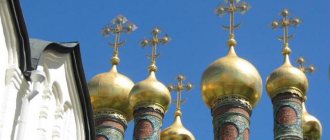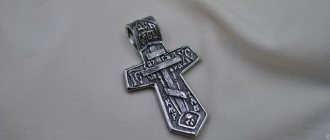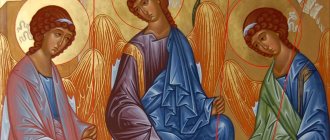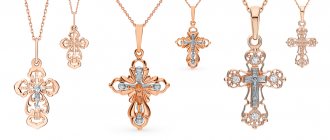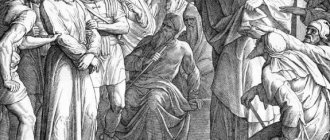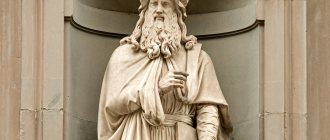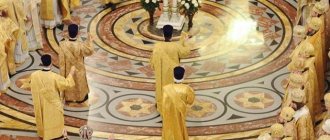"Save me, God!".
Thank you for visiting our website, before you start studying the information, please subscribe to our Orthodox community on Instagram, Lord, Save and Preserve † - https://www.instagram.com/spasi.gospodi/. The community has more than 60,000 subscribers. There are many of us like-minded people and we are growing quickly, we post prayers, sayings of saints, prayer requests, and timely post useful information about holidays and Orthodox events... Subscribe. Guardian Angel to you!
As you know, each faith has a distinctive feature, thanks to which it can be distinguished from each other. For Orthodoxy it is a cross, but for the Islamic faith it is a crescent with a star inside. But there are symbols that are not similar in appearance to traditional elements of faith. One of the elements that makes us think about the unity of faith is the cross of Nikon, on which there is a crescent under the cross.
Cross in other cultures
The cross as a special symbol existed in different cultures even before the advent of Christianity. For example, among the pagans this sign symbolized the sun. There are echoes of this meaning in modern Christian interpretation. For Christians, the cross is the sun of truth, which complements the personification of salvation after Jesus Christ was crucified.
In this context, the meaning of the crescent on the Orthodox cross can be understood as the victory of the sun over the moon. This is an allegory of the victory of light over darkness or day over night.
Meaning and symbols
Today you can find many interpretations of this symbolism. It is quite clear that in any religion everything is symbolic. Therefore, a crescent moon can represent not only a celestial body, but also completely different things. Moreover, if it were really a crescent, then its location would be completely different, and not upside down, as we are used to seeing.
Here is a list of the main interpretations that are accepted by the Orthodox Church.
- Anchor. The Apostle Paul, in one of his letters to the ancient people, tells that the Cross on which Jesus Christ was crucified signifies an anchor that all believers should take hold of, as hope, so as not to drown in the godless world of passions. Therefore, the image of the usual eight-pointed cross with a crescent at the base is more reminiscent of a ship’s anchor. Moreover, the ends of the month are shaped like an arrow. It is no coincidence that it is located on the domes, so that everyone can see from afar that only here is a refuge for the salvation of human souls.
- Power. Here it is necessary to return again to Byzantium and remember that the crescent signifies belonging to the royal family and is a symbol of a person invested with royal power. The head of the Church in Orthodoxy is Jesus Christ. He is the head, the Lord, the King. Therefore, not only Temples are crowned with tsats, but they can also be seen on icons of the Savior.
- Font. The most important event in the life of an Orthodox Christian is his Baptism. Through baptism, a person is aligned with God, gets rid of original sin and can inherit the Kingdom of God. Therefore, the font in which this most important Sacrament takes place is symbolically depicted on temple domes.
- Nursery. Some religious scholars claim that the unfinished oval at the base is nothing more than the manger in which the Infant God rested. That he came to earth to save people, not as a Strict Judge and Punisher, but as a Meek Teacher and Savior, to save perishing humanity from the slavery of sin and the Devil.
- Bowl. Every Sunday in all Orthodox churches the Sacrament of the Eucharist (Thanksgiving) or, as it is most often called, Communion is celebrated, when believers with love and reverence partake of the Body and Blood of Their Savior, offering him songs of thanks and praise. So it is quite likely that the crescent also means the Cup from which the clergy give the Holy Gifts to the believers.
- Sail. The Church is often called the ship that leads all believers to salvation. Therefore, a cross with a crescent means a kind of sail that helps to “sail” in the right direction.
Despite the interpretations, it must be remembered that this symbol was approved by Constantine the Great as confirmation that Orthodoxy had become the main state faith.
Crescent or boat: versions of the origin of the sign
There are several versions of what exactly the crescent moon on the Orthodox cross symbolizes. Among them we highlight the following:
- This sign is not a crescent at all. There is another ancient symbol that is visually similar to it. The cross as a symbol of Christianity was not immediately approved. Constantine the Great established Christianity as the main religion of Byzantium, and this required a new recognizable symbol. And for the first three centuries, the graves of Christians were decorated with other signs - a fish (in Greek “ichthys” - the monogram “Jesus Christ the Son of God the Savior”), an olive branch or an anchor.
- The anchor also has a special meaning in the Christian religion. This sign means hope and inviolability of faith.
- Also, the Bethlehem manger resembles a crescent moon. It was in them that Christ was found as a child. The cross rests on the birth of Christ and grows from his cradle.
- The Eucharistic cup, which contains the Body of Christ, may be implied by this sign.
- This is also a symbol of the ship led by Christ the Savior. The cross in this sense is a sail. The Church under this sail is sailing towards salvation in the Kingdom of God.
All these versions are true to some extent. Each generation has put its own meaning into this sign, which is so important for Christian believers.
What does the crescent on an Orthodox cross mean?
The crescent is a complex and ambiguous symbol. The centuries-old history of Christianity has left many imprints and legends on it. So what does the crescent on an Orthodox cross mean in the modern sense? The traditional interpretation is that it is not a crescent, but an anchor - a sign of firm faith.
Evidence for this statement can be found in the Bible's book of Hebrews (Hebrews 6:19). Here Christian hope is called a safe and strong anchor in this turbulent world.
But during Byzantium, the crescent moon, the so-called tsata, became a symbol of royal power. Since then, temple domes began to be decorated with crosses with a tsata at the base to remind people that the King of Kings owns this house. Sometimes this sign was also used to decorate icons of saints - the Most Holy Theotokos, Trinity, Nicholas and others.
What is at the base of the cross on the dome?
In their external shape, domed crosses often differ from the eight-pointed ones we are used to. The cross on the dome expresses the idea of the temple as the House of God and the ship of Salvation and has corresponding symbolism. Questions and confusion arise especially often about the crescent (tsata), located at the bottom of the cross. What meaning does this symbol carry?
First of all, you need to keep in mind that the crescent on the Orthodox cross has nothing to do with either the Muslim religion or victory over Muslims. Crosses with the image of a tsata (crescent) decorated ancient churches: the Church of the Intercession on the Nerl (1165), Demetrius Cathedral in Vladimir (1197) and others.
There could be no talk of any victory over the Muslims then.
The crescent has been the state sign of Byzantium since ancient times, and only after 1453, when Constantinople was captured by the Turks, did this Christian symbol become the official emblem of the Ottoman Empire. In Orthodox Byzantium, tsata symbolized royal power. Apparently, this is why it is placed as a symbol of grand-ducal dignity in the image of the Kyiv prince Yaroslav Izyaslavich in the “Royal Chronicler” of the 16th century. Often the tsata (crescent) is depicted as part of the holy vestment of St. Nicholas the Wonderworker. It can also be found on other icons: the Holy Trinity, the Savior, the Blessed Virgin Mary. All this gives the right to believe that the tsata on the cross is a symbol of the Lord Jesus Christ as King and High Priest. Thus, the installation of a cross with a tsata on the dome of the temple reminds us that this temple belongs to the King of kings and the Lord of lords.
In addition, from ancient times - from Christ and the first centuries of Christianity - another meaning of the cross with a crescent came to us. In one of his epistles, the Apostle Paul teaches that Christians have the opportunity to “take hold of the hope that is set before us, that is, the Cross, which is like a safe and strong anchor for the soul” (Heb. 6:18-19). This “anchor”, which at the same time symbolically covers the cross from the desecration of the pagans, and reveals to faithful Christians its true meaning - deliverance from the consequences of sin, is our strong hope. Only a church ship has the power to deliver everyone through the waves of a stormy temporary life to the quiet haven of eternal life.
On the domes of the Church of St. Sophia of Vologda (1570), the Holy Trinity Cathedral of Verkhoturye (1703), the Church of Blessed Cosmas in the city of Kostylevo, there are crosses with a bizarre ornament: twelve stars on rays emanating from the center and with a crescent below. The symbolism of such a cross clearly conveys the image from the revelation of John the Theologian: “And a great sign appeared in heaven: a woman clothed with the sun, with the moon under her feet, and on her head a crown of 12 stars” - as a sign that, originally assembled from 12 tribes Israel, it was subsequently led by 12 apostles, who constituted its luminous glory.
Sometimes the cross on a temple (with or without a crescent) is not eight-pointed, but four-pointed. Many crosses on the ancient and most famous Orthodox cathedrals have exactly this shape - for example, the Hagia Sophia Cathedral in Constantinople (8th century), the Hagia Sophia Cathedral in Kiev (1152), the Assumption Cathedral in Vladimir (1158), the Church of the Savior in Pereyaslavl (1152 year) and many other temples. Starting from the 3rd century, when four-pointed crosses first appeared in the Roman catacombs, and until today, the entire Orthodox East considers this form of cross to be equal to others.
In addition to the above meanings of the crescent, there are others in the patristic tradition - for example, that it is the Bethlehem cradle that received the Divine Infant Christ, the Eucharistic cup in which the Body of Christ is located, the church ship and the baptismal font.
That's how many meanings and mysterious spiritual meaning there are in the cross that shines above the dome of the temple.
Church Herald
Similar
False interpretations
In search of an answer to the question of why the crescent moon is at the bottom on the Orthodox cross, people often associate this sign with Islam. Allegedly, the Christian religion thus demonstrates its eminence over the Muslim world by trampling the crescent moon with a cross. This is a fundamentally wrong belief. The crescent began to symbolize the Islamic faith only in the 15th century, and the first recorded image of a Christian cross with a crescent dates back to the monuments of the 6th century. This sign was found on the wall of the famous Sinai monastery named after St. Catherine. Pride and oppression of another faith contradict the main principles of Christianity.
The church cross, as an integral part of the life of every Orthodox person
Every Orthodox person makes his first acquaintance with the cross at the moment of baptism, throughout his life he encounters it so often, and on his last journey the Orthodox cross accompanies each of us.
Since time immemorial, crosses have been installed at crossroads and at the entrance to cities and villages. A special feature of the installation is the ability to determine the cardinal directions using the cross on the church .
The direction of the cross on the dome of the church always corresponds to the west-east plane, in addition, the raised small crossbar of the cross points to the south.
The seven sacred Sacraments are performed with the church cross; it is laid at the foundation of the church during construction and in the interior decoration of each temple, the cross is an indispensable attribute. And, of course, church domes are crowned with a cross.
Looking at the great many churches in the vastness of our Motherland, you wonder why there are different crosses on churches? It turns out that every cross on the dome of the Orthodox Church expresses the idea of the temple as the House of God and the ship of Salvation and has corresponding symbolism. The Monk Theodore the Studite said: “The cross of any form is the true cross.”
And how much spirituality and beauty there is in all the variety of church crosses made and installed.
Although only their contemplation can quite fully convey all the incredible and magnetic beauty that the masters have given us, in this article we will lightly touch on these works of art and try to understand the meanings of the crosses on the dome of the Orthodox Church .
Crescent and star
They themselves do not argue with the fact that Muslims borrowed the crescent sign from Byzantium. The crescent and star predate Islam by several thousand years. Many sources agree that these are ancient astronomical symbols that were used by Central Asian and Siberian tribes to worship the sun, moon and pagan gods. Early Islam also did not have a main symbol; they were adopted somewhat later, like the Christians. The crescent on the Orthodox cross appeared no earlier than the 4th-5th centuries, and this innovation had political overtones.
The crescent and star have only become associated with the Muslim world since the Ottoman Empire. According to legend, Osman, its founder, had a dream in which a crescent moon rose above the ground from edge to edge. Then in 1453, after the Turks conquered Constantinople, Osman made the crescent and star the coat of arms of his dynasty.
History of the Crescent
The crescent, which was also commonly called tsata, was initially considered the state symbol of Byzantium; it symbolized power.
After the Turks conquered Constantinople and renamed it Istanbul, it became a symbol of the Ottoman Empire. In Ancient Rus', the crescent was also considered a symbol of power; it was customary to place it on images of princes.
Tsata was often placed on icons as an additional decoration. The crescent moon is found on the icons of the Trinity and the Mother of God, St. Nicholas the Wonderworker.
Tsata became widespread in Rus' in the 17th century; it was customary to depict it in the form of an inverted kokoshnik. Crosses with crescents were often installed on churches, which were constantly visited by rulers and princes. The symbol crowns many Kremlin cathedrals, as well as recently built churches in the Old Russian style.
Differences between crosses in Christian denominations
There are a great many variations of crosses in Christianity. This is not surprising, since this is one of the largest faiths - about 2.5 billion people around the world identify themselves with it. We have already found out what the crescent on the cross of an Orthodox church means, but this is not its only form.
It is generally accepted that in Protestantism and Catholicism the cross always has 4 ends. And the Orthodox or Orthodox crosses have more of them. This is not always an accurate statement, since even the Papal Cross looks different from the 4-pointed one.
On our monasteries and churches they install the cross of St. Lazarus, and it is 8-pointed. The crescent on the Orthodox cross also emphasizes strong faith. What does an oblique crossbar mean under a horizontal one? There is a separate biblical legend on this topic. As we see, Christian symbols cannot always be understood literally; to do this, it is worth delving more deeply into the history of world religion.
History of appearance
In the Orthodox religion, the crescent on the cross is usually called tsata. Tsatsa decorated crosses on churches at the beginning of the second millennium. They can be seen on one of the oldest churches that have survived to this day - the Church of the Intercession on the Nerl (1165).
Since ancient times, this Byzantine symbol denoted royal power. Therefore, the crescent was placed on the image of the Kyiv prince Yaroslav in the “Royal Chronicler” back in the 16th century. And only after the conquest of Constantinople by Turkish troops, this symbol was “pumped” into Islam. You can also see the crescent moon on icons of saints. For example, on the vestments of Nicholas the Wonderworker, as well as the Savior Jesus Christ Himself and His Mother, the Most Holy Theotokos and the Ever-Virgin Mary.
Today, historians do not undertake to assert the exact time of the appearance of tsata, but it is known for certain that such a symbol was present in Christianity even before the baptism of Rus' by Prince Vladimir.
